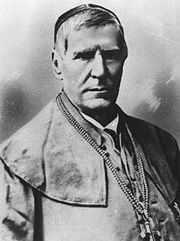
Motiejus Valancius
Encyclopedia

Biography
Motiejus Valančius was born February 16, 1801, into a well-to-do peasant family in Narsėnai village, Kretinga district. Early in his youth, he had his baptismal records altered to indicate noble birth; the family name was Polonized to Wołonczewski. This practice, not uncommon among prosperous villagers, was a means of providing educational opportunities otherwise denied to peasant children. In 1816 he entered the Dominican school at Žemaičių KalvarijaŽemaiciu Kalvarija
Žemaičių Kalvarija is a small town in Plungė district municipality, Lithuania. It is known as a major site for Catholic pilgrimage....
and six years later began his studies at the Theological Seminary in Varniai. He transferred to the Vilnius Priest Seminary in 1824, from which he graduated in 1828. Ordained a priest that same year, he spent the next six years teaching religion in Belarus
Belarus
Belarus , officially the Republic of Belarus, is a landlocked country in Eastern Europe, bordered clockwise by Russia to the northeast, Ukraine to the south, Poland to the west, and Lithuania and Latvia to the northwest. Its capital is Minsk; other major cities include Brest, Grodno , Gomel ,...
. In 1834 he returned to Lithuania to take up a teaching position at the Kražiai
Kražiai
Kražiai is a town in Lithuania, located in the Kelmė district municipality, between Varniai and Raseiniai , on the Kražantė river. The old town of Kražiai is an archeological and urban monument....
secondary school.
In 1840 he was assigned to the Vilnius Theological Seminary
Saint Petersburg Roman Catholic Theological Academy
The Saint Petersburg Roman Catholic Theological Academy was an institution of higher education preparing Roman Catholic theologians in the Russian Empire. The Academy granted master's and doctorate degrees in theology and was designed to prepare officers for senior positions in the Catholic Church...
, where he lectured in pastoral theology and biblical archaeology and where he earned his doctorate in theology in 1842. That same year on orders of the Tsar, the Academy, it teaching staff and student body, was moved to St. Petersburg, Russia. Valančius came back to Lithuania because of health problems in 1845 and was appointed rector of the Varniai Theological Seminary, serving in this capacity until 1850. Having been absent from Lithuania during the anti-Russian uprising in 1831
November Uprising
The November Uprising , Polish–Russian War 1830–31 also known as the Cadet Revolution, was an armed rebellion in the heartland of partitioned Poland against the Russian Empire. The uprising began on 29 November 1830 in Warsaw when the young Polish officers from the local Army of the Congress...
, Valančius was considered to be relatively apolitical, and thus the Russian government did not object when he was proposed as Episcopal candidate for the see of Samogitia.
Bishop

Temperance movement
A temperance movement is a social movement urging reduced use of alcoholic beverages. Temperance movements may criticize excessive alcohol use, promote complete abstinence , or pressure the government to enact anti-alcohol legislation or complete prohibition of alcohol.-Temperance movement by...
, which grew to encompass nearly a million members, almost half of the county’s population. he also wrote first Lithuanian language history of Samogitian diocese, that has not lost its scientific value until nowadays.
His pastoral and educational work was interrupted by the uprising of 1863–1864
January Uprising
The January Uprising was an uprising in the former Polish-Lithuanian Commonwealth against the Russian Empire...
and was made extremely difficult as the Russian government tightened its reins after the collapse of the revolt. Yet these circumstances did not prevent him from following a course which could not but bring him into direct conflict with the authorities. He made every effort to undermine the government’s scheme of Russification
Russification
Russification is an adoption of the Russian language or some other Russian attributes by non-Russian communities...
. In 1874 Valančius fell ill and died in Kaunas
Kaunas
Kaunas is the second-largest city in Lithuania and has historically been a leading centre of Lithuanian economic, academic, and cultural life. Kaunas was the biggest city and the center of a powiat in Trakai Voivodeship of the Grand Duchy of Lithuania since 1413. During Russian Empire occupation...
on May 29, 1875. He was interred in the crypt
Crypt
In architecture, a crypt is a stone chamber or vault beneath the floor of a burial vault possibly containing sarcophagi, coffins or relics....
of the Kaunas Cathedral Basilica
Kaunas Cathedral Basilica
Kaunas Cathedral Basilica is a Roman Catholic cathedral basilica in Kaunas, Lithuania.The exact date when the first Gothic style church dedicated to apostles Saint Peter and Saint Paul, was built is unknown, but it was first mentioned in written sources in 1413. The first parochial school in...
.
Legacy
He services to the Lithuanian cause were lasting and important. His opposition to the Russian government and the tactics he employed in resisting its policies, particularly Lithuanian press banLithuanian press ban
The Lithuanian press ban was a ban on all Lithuanian language publications printed in the Latin alphabet within the Russian Empire, which controlled Lithuania at the time. Lithuanian-language publications that used the Cyrillic alphabet were allowed and even encouraged...
. He sponsored the illegal practice of printing Lithuanian books in East Prussia
East Prussia
East Prussia is the main part of the region of Prussia along the southeastern Baltic Coast from the 13th century to the end of World War II in May 1945. From 1772–1829 and 1878–1945, the Province of East Prussia was part of the German state of Prussia. The capital city was Königsberg.East Prussia...
and smuggling them into Lithuania by knygnešiai
Knygnešiai
Book smugglers were people who transported Lithuanian language books printed in the Latin alphabet into Lithuanian-speaking areas of the Russian Empire, defying a ban on such materials in force from 1866 to 1904...
, served to stimulate the emergence of the Lithuanian national movement. An educator, and able Church administrator, historian and ethnographer, and a talented writer, Valančius emerges as one of the most versatile and influential figures in the 19th century Lithuania.

